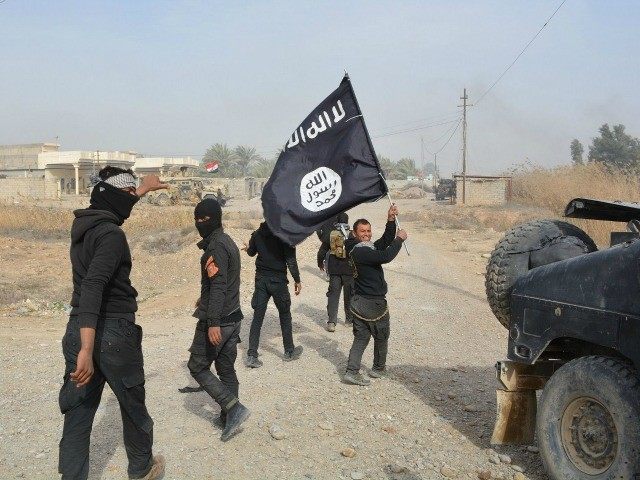An unsettling report from the Soufan Center, a security consulting firm based in Washington, finds that a large number of Islamic State fighters from Western countries have returned home, while many others are completely unaccounted for, including 122 Americans.
The 122 missing jihadis represent nearly all of the Americans who traveled to Syria and Iraq to fight for ISIS. A grand total of 129 people are known to have left the United States to serve the Islamic State, according to the Soufan Center report, but only seven of them are known to have returned home.
Fox News quotes security expert Lee Oughton of the Abbey Grey Group responding to the Soufan Center’s findings:
This is only what we know and what official records report. What about those that are still transiting illegally and freely across borders? The borders going into the U.S. are seen as porous and could be an ideal spot for returning ISIS fighters to filter undetected back into society.
A startling degree of our information about this potentially devastating terrorist problem is pure conjecture. For instance, Fox News notes the U.S. government estimates that about twenty percent of the Americans who fought for ISIS were killed on the battlefield, but there are no precise figures.
Virtually nothing seems to be known about the whereabouts or intentions of most of the survivors. The Soufan Center notes there are also people who were stopped en route to the Islamic State and may retain “all the fire and enthusiasm of a new recruit” but none of the disillusionment because they never got to live in the hellish conditions of the “caliphate.”
Overall, there are at least 5,600 Islamic State recruits from 33 countries who are returning home, which presents a significant security risk even without considering the unknown number of ISIS jihadis who are completely unaccounted for. Somewhere between 30 and 50 percent of the Islamic State recruits from Europe are said to be attempting to return home.
The Soufan Group found governments around the world struggling to deal with returnees, especially since many of them are women and children. It seems reasonable to expect the children will need extensive mental health services after living under the Islamic State, as well as security monitoring as they grow up. The report notes that ISIS considers everyone over 15 to be an adult and has trained much younger children as killers in its sickening “Cubs of the Caliphate” program.
As for the women, the extent to which ISIS authorized and trained female fighters in the fading days of the caliphate remains a matter of debate, but there is no doubt women worked as recruiters and enforcers, eagerly participating in the sadistic atrocities of the Islamic State.
The Soufan Center report notes that ISIS has not thrown in the towel after losing its treasured “caliphate” in Syria and Iraq: “Already its propaganda has cast the eradication of its territorial control in Syria and Iraq as unimportant, and merely a temporary setback in its preordained journey to victory, and it has promised more attacks in the West.”
“It is highly likely that even as the territorial caliphate shrinks and is increasingly denied an overt presence, its leadership will look to supporters overseas, including returnees, to keep the brand alive,” warns the report.
It is suggested that returnees will feel so detached from daily life in their home countries that they will be easily recruited to new jihad activities. They will have plenty of contacts from their days in the caliphate who know how to get in touch with them and can appeal to their loyalty as former brothers-in-arms.
It is possible that fighters from Syria and Iraq who have escaped detection by the authorities will be diverted to other Islamic State battlefields, such as the dangerous insurgency in the Philippines.
The Soufan Group argues that the last fighters to flee from Syria and Iraq were probably those most committed to the cause and most willing to carry out new insurgent campaigns or terrorist attacks in the name of the Islamic State.
Some of these fighters were sent out of the caliphate deliberately by ISIS leadership, as the noose tightened around Mosul and Raqqa, in the hope they would fight elsewhere to keep the dreams of the terror state alive. Many of them appear to have been trained in how to get past immigration authorities and avoid deportation. Returnees from the caliphate will also be able to take advantage of resources used by ISIS leadership to insert terrorist operatives into Western nations.
Another danger is that other terrorist organizations and criminal gangs will scoop up disaffected ISIS members, particularly if rivals like al-Qaeda believe ISIS is going down for good and therefore abandon concerns about infiltrators from ISIS taking over their organizations. Survivors of the Syrian and Iraqi battlefields will have military experience that makes them valuable recruits for other jihadi organizations or organized crime rings.
The question of what to do with returning jihadis is difficult. The Soufan Group notes that incarcerating them is expensive, often tricky from a legal standpoint, and runs the risk of either further radicalizing returnees or giving them a chance to radicalize fellow prisoners.
As for rehabilitating and reintegrating returnees, the report dourly notes that “most returnees were never integrated in the first place,” and most rehab programs attempted thus far have failed. Unfortunately, the report ends without really proposing a better solution than mass incarceration, rehabilitation, or deportation programs that might simply end up shuffling jihadis from one country to another.

COMMENTS
Please let us know if you're having issues with commenting.